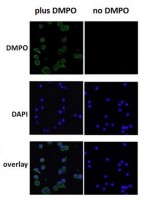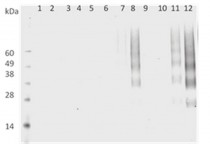ARG20538
anti-DMPO Nitrone Adduct antibody [N166A4]
anti-DMPO Nitrone Adduct antibody [N166A4] for ELISA,ICC/IF,IHC-Formalin-fixed paraffin-embedded sections,Immunoprecipitation,Western blot and Other
Cell Biology and Cellular Response antibody; Metabolism antibody; Signaling Transduction antibody
Overview
| Product Description | Mouse Monoclonal antibody [N1664A] recognizes DMPO Nitrone Adduct |
|---|---|
| Tested Reactivity | Other |
| Tested Application | ELISA, ICC/IF, IHC-P, IP, WB |
| Specificity | Recognizes DMPO, DMPO-octanoic acid, DMPO-protein adducts and DMPO-DNA adducts. Does not cross react with non-adducted proteins or DNA. |
| Host | Mouse |
| Clonality | Monoclonal |
| Clone | N1664A |
| Isotype | IgG1 |
| Target Name | DMPO Nitrone Adduct |
| Immunogen | 5,5-dimethyl-2-(8-octanoic acid)-1-pyrrolone-N-oxide conjugated to Ovalbumin |
| Conjugation | Un-conjugated |
Application Instructions
| Application Suggestion |
|
||||||||||||
|---|---|---|---|---|---|---|---|---|---|---|---|---|---|
| Application Note | * The dilutions indicate recommended starting dilutions and the optimal dilutions or concentrations should be determined by the scientist. |
Properties
| Form | Liquid |
|---|---|
| Purification | Purification with Protein G. |
| Buffer | PBS (pH 7.4), 50% Glycerol and 0.09% Sodium azide |
| Preservative | 0.09% Sodium azide |
| Stabilizer | 50% Glycerol |
| Concentration | 1 mg/ml |
| Storage Instruction | For continuous use, store undiluted antibody at 2-8°C for up to a week. For long-term storage, aliquot and store at -20°C. Storage in frost free freezers is not recommended. Avoid repeated freeze/thaw cycles. Suggest spin the vial prior to opening. The antibody solution should be gently mixed before use. |
| Note | For laboratory research only, not for drug, diagnostic or other use. |
Bioinformation
| Background | The formation of free radicals and other highly reactive oxygen species has been implicated in the pathogenesis of many disease states. The ability to identify these species is crucial, and spin trapping has accomplished this goal. DMPO (5,5-dimethyl-1-pyrroline N-oxide) is one of the least toxic to cells and animals, and possesses convenient pharmacokinetics (uptake, distribution, metabolism and excretion) in biological systems. Recent studies have determined that nitric oxide may substantially affect the quantitative determination of DMPO adducts, and therefore extra caution is required when studying generation of these species in the presence of nitric oxide or its radicals. DMPO adducts can be generated with protein and DNA radicals. |
|---|---|
| Research Area | Cell Biology and Cellular Response antibody; Metabolism antibody; Signaling Transduction antibody |
Images (2) Click the Picture to Zoom In
-
ARG20538 anti-DMPO Nitrone Adduct antibody [N166A4] ICC/IF image
Immunofluorescence: Mouse macrophage cell lines stained with ARG20538 anti-DMPO Nitrone Adduct antibody [N166A4] at 10 ug/ml dilution.
-
ARG20538 anti-DMPO Nitrone Adduct antibody [N166A4] WB image
Western blot: 1) 10 uM Hb (Hemoglobin), 2) 10 uM Hb + 100 uM HOCI, 3) 10 uM Hb + 500 uM HOCI, 4) 10 uM Hb + 1000 uM HOCI, 5)-8) as above with 20 mM DMPO, 9)-12) as above with 100 mM DMPO. Staining with ARG20538 anti-DMPO Nitrone Adduct antibody [N166A4].







